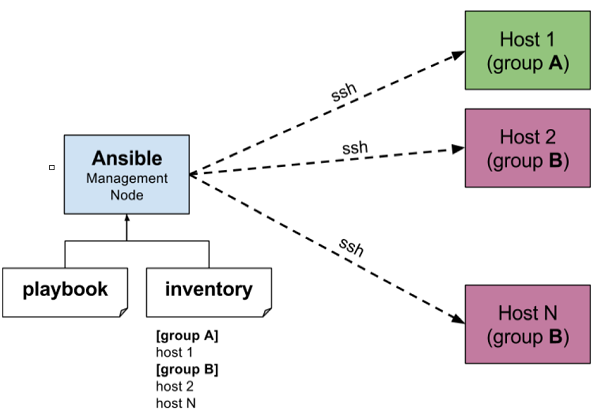
Ansible - Introduction
Ansible is simple open source IT engine which automates application deployment, intra service orchestration, cloud provisioning and many other IT tools.
Ansible is easy to deploy because it does not use any agents or custom security infrastructure.
Ansible uses playbook to describe automation jobs, and playbook uses very simple language i.e. YAML (Its a human-readable data serialization language & is commonly used for configuration files, but could be used in many applications where data is being stored)which is very easy for humans to understand, read and write. Hence the advantage is that even the IT infrastructure support guys can read and understand the playbook and debug if needed (YAML It is in human readable form).
Ansible is designed for multi-tier deployment. Ansible does not manage one system at time, it models IT infrastructure by describing all of your systems are interrelated. Ansible is completely agentless which means Ansible works by connecting your nodes through ssh(by default). But if you want other method for connection like Kerberos, Ansible gives that option to you.
After connecting to your nodes, Ansible pushes small programs called as Ansible Modules. Ansible runs that modules on your nodes and removes them when finished. Ansible manages your inventory in simple text files (These are the hosts file). Ansible uses the hosts file where one can group the hosts and can control the actions on a specific group in the playbooks.
Sample Hosts File
This is the content of hosts file −
#File name: hosts #Description: Inventory file for your application. Defines machine type abc node to deploy specific artifacts # Defines machine type def node to upload metadata. [abc-node] #server1 ansible_host = <target machine for DU deployment> ansible_user = <Ansible user> ansible_connection = ssh server1 ansible_host = <your host name> ansible_user = <your unix user> ansible_connection = ssh [def-node] #server2 ansible_host = <target machine for artifact upload> ansible_user = <Ansible user> ansible_connection = ssh server2 ansible_host = <host> ansible_user = <user> ansible_connection = ssh
What is Configuration Management
Configuration management in terms of Ansible means that it maintains configuration of the product performance by keeping a record and updating detailed information which describes an enterprises hardware and software.
Such information typically includes the exact versions and updates that have been applied to installed software packages and the locations and network addresses of hardware devices. For e.g. If you want to install the new version of WebLogic/WebSphere server on all of the machines present in your enterprise, it is not feasible for you to manually go and update each and every machine.
You can install WebLogic/WebSphere in one go on all of your machines with Ansible playbooks and inventory written in the most simple way. All you have to do is list out the IP addresses of your nodes in the inventory and write a playbook to install WebLogic/WebSphere. Run the playbook from your control machine & it will be installed on all your nodes.
How Ansible Works?
The picture given below shows the working of Ansible.
Ansible works by connecting to your nodes and pushing out small programs, called "Ansible modules" to them. Ansible then executes these modules (over SSH by default), and removes them when finished. Your library of modules can reside on any machine, and there are no servers, daemons, or databases required.

The management node in the above picture is the controlling node (managing node) which controls the entire execution of the playbook. Its the node from which you are running the installation. The inventory file provides the list of hosts where the Ansible modules needs to be run and the management node does a SSH connection and executes the small modules on the hosts machine and installs the product/software.
Beauty of Ansible is that it removes the modules once those are installed so effectively it connects to host machine , executes the instructions and if its successfully installed removes the code which was copied on the host machine which was executed.